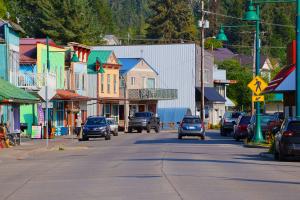Economic Conditions Reports
To support informed decision-making and transparent public communication, the City and Borough of Wrangell seeks to conduct economic analysis and reporting on a semi-annual basis. These updates help track trends across key sectors, measure the effectiveness of local initiatives, and identify emerging opportunities and challenges. Regular reporting also ensures that Borough leadership, businesses, and residents share a common understanding of Wrangell’s economic landscape as the community plans for sustainable growth.
The Wrangell Economic Conditions Report (2025), prepared by Rain Coast Data, provides an updated look at the Borough’s evolving economy and key trends shaping its future. The analysis outlines both ongoing challenges and emerging opportunities across Wrangell’s major industries.
Key Findings:
Tourism is Growing: Tourism is entering its strongest period in twenty years. Wrangell is projected to host more than 45,000 cruise visitors in 2025 and nearly 80,000 in 2026. Between 2019 and 2024, tourism jobs grew by 13% and wages by 46%, underscoring the sector’s importance to local growth. To fully benefit from this increase, Wrangell must continue expanding shore excursions and visitor amenities.
Demographics Drive Economic Weaknesses: Population loss remains Wrangell’s most significant long-term challenge. The Borough’s population has declined by 15% since 2012, and current projections suggest an additional 34% decline by 2050 if trends continue. Residents aged 60 and over now make up 37% of the population, compared to 10% in 1990, while the working-age population continues to shrink.
Healthcare,The Economic Cornerstone: Healthcare has become Wrangell’s largest industry, generating $15.2 million in wages in 2024 and supporting 171 jobs—more than either the government or seafood sectors. Employment in healthcare has grown by 53% since 2016, anchored by SEARHC’s Wrangell Medical Center.
Seafood Continues to Struggle: The seafood sector remains vital but challenged. In 2024, seafood accounted for 18% of local jobs and 20% of wages, yet the Port of Wrangell’s seafood value was 50% below 2019 levels. Weak salmon returns, global oversupply, and low prices continue to affect the industry. Dungeness crab now represents nearly half of Wrangell’s total fishery value.
Business Climate, Cautious but Improving: Wrangell businesses reported one of the more challenging business environments in the region in 2025, with around 60% rating current conditions as poor or very poor—a reflection of continued pressures in the seafood and maritime sectors. However, local outlooks are improving. Sixty percent of businesses expect good or improving conditions in the coming year, led by growing confidence in the visitor industry and emerging opportunities tied to port development. While the overall climate remains cautious, Wrangell’s business community is showing resilience and optimism about the year ahead.
The City and Borough of Wrangell continues to pursue economic initiatives identified through long-term community planning, including stimulating housing development in the Alder Top Village (Keishangita.'aan) subdivision; expanding waterfront infrastructure with a second cruise dock in partnership with American Cruise Lines; relocating industrial waterfront activities, such as barge operations, from downtown to the Six Mile area; and investing in both new and existing public infrastructure— such as harbor basin renovations, road replacements, and the completion and ongoing maintenance of the new water treatment plant.
To succeed, Wrangell will need to actively pursue new growth opportunities, invest in and maintain essential infrastructure, support the continued vitality of its core industries, and create a community environment where workers and young families can thrive. These efforts, taken together, will be key to ensuring Wrangell’s long-term economic stability and quality of life.

